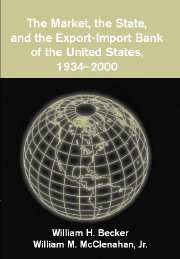Book contents
- Frontmatter
- Contents
- Preface and Acknowledgments
- Introduction
- 1 Setting a Flexible Course: The Export-Import Bank, 1934–1939
- 2 World War and Its Aftermath
- 3 Cold War and the Needs of a New Era, 1948–1961
- 4 Becoming “Two Institutions”
- 5 New Mandates and New Limits
- 6 Turmoil and Turning Points
- 7 A New Era and Its Challenges, the 1990s
- Epilogue
- Appendix A Board of Directors
- Appendix B Summary of Authorizations
- Appendix C Number of Authorizations
- Appendix D Charges Against Statutory Limitations on Total Activity
- Index
3 - Cold War and the Needs of a New Era, 1948–1961
Published online by Cambridge University Press: 13 July 2009
- Frontmatter
- Contents
- Preface and Acknowledgments
- Introduction
- 1 Setting a Flexible Course: The Export-Import Bank, 1934–1939
- 2 World War and Its Aftermath
- 3 Cold War and the Needs of a New Era, 1948–1961
- 4 Becoming “Two Institutions”
- 5 New Mandates and New Limits
- 6 Turmoil and Turning Points
- 7 A New Era and Its Challenges, the 1990s
- Epilogue
- Appendix A Board of Directors
- Appendix B Summary of Authorizations
- Appendix C Number of Authorizations
- Appendix D Charges Against Statutory Limitations on Total Activity
- Index
Summary
INTRODUCTION
In 1948, President William McChesney Martin looked forward to the end of the Bank's role in European reconstruction. One might say that he hoped for normalcy. The Ex-Im's activity in that year focused on agricultural credits and developmental lending, two well-established areas of its business. By the early 1950s, much of the Ex-Im's activities were devoted to developmental lending in Latin America, an area familiar to the institution.
But the year 1948 proved anything but normal for the United States. Already troubled relations with the Soviet Union deteriorated even further with a series of events between 1947 and June 1950 – the start of the Korean War – which froze U.S.–USSR relations in the bitter standoff that came to be known as the Cold War. As a result, the Bank increased lending to promote the production of strategic materials, which in turn opened the Ex-Im to business in the Middle East, Africa, and Asia, places where its role had earlier been either minimal or nonexistent. The increasing scope and volume of the Bank's business required larger budgets for staff and greater attention to the intricacies of managing expanding operations.
The decade following 1947 also witnessed significant changes in the United States' place in the international economy. As Europe's and Japan's industrial base recovered from the damage of World War II, the United States lost its unusual postwar preeminence in world markets.
- Type
- Chapter
- Information
- Publisher: Cambridge University PressPrint publication year: 2003



